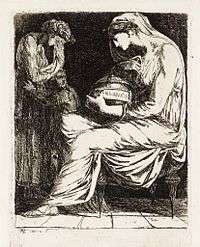Alexander Runciman
.jpg)
Alexander Runciman (Edinburgh 15 August 1736 – 4 October 1785 Edinburgh) was a Scottish painter of historical and mythological subjects. He was the elder brother of John Runciman, also a painter.


Life
He was born in Edinburgh, and studied at the Foulis Academy, Glasgow, and from 1750 to 1762 he was apprenticed to the landscape painter Robert Norie, later becoming a partner in the Norie family firm. He also worked as a stage painter for the Theatre Royal in Edinburgh.
In 1767, he went to Rome, where he spent five years. His brother John accompanied him, but died in Naples in the winter of 1768–69. During Runciman's stay in Italy he became acquainted with other artists such as Henry Fuseli and the sculptor Johan Tobias Sergel. Runciman's earliest efforts had been in landscape; he now turned to historical and imaginative subjects, exhibiting his Nausicaa at Play with her Maidens in 1767 at the Free Society of British Artists, Edinburgh.
On his return from Italy after a brief time in London, where in 1772 he exhibited in the Royal Academy, he settled in Edinburgh, and was appointed master of the Trustees' Academy. He was patronised by Sir James Clerk, whose hall at Penicuik House he decorated with a series of subjects from Ossian. He also created various religious paintings and an altar-piece in the Cowgate Episcopal Church, Edinburgh, and easel pictures of Cymon and Iphigenia, Sigismunda Weeping over the Heart of Tancre, and Agrippina with the Ashes of Germanicus.
In 1773 he is listed as sharing a studio with a Mr McLarin at the foot of Old Assembly Close off the Royal Mile (facing what is now called the Cowgate).[1]
He enjoyed a strong reputation as a landscape painter is his lifetime. Some of his works, due to their spontaneity, vigour of style and colour, and unorthodox composition, place him as an early exponent of modern art.
Keith Ralph studied under Alexander Runciman.
Runciman died in Edinburgh and is buried in Canongate Churchyard. The grave is unmarked but a stone plaque was erected by the RSA in 1866 on the west-facing wall of the church to his memory (also commemorating his brother John who died in Naples).
Known Works
- Robert Fergusson
- East Lothian Landscape
- Dunvegan Castle
- The Blind Ossian Singing
- Self portrait with John Brown
- The Witches Showing MacBeth the Apparitions
- Fingal Encounters Carbon Carglass
- Agrippina with the Ashes of Germanicus
- Hubert and Arthur
- Agrippina Landing at Brundisium
- A View near Perth
- Italian River Landscape with a Hermit
- David Steuart Erskine
- Temple of the Sibyl at Tipoli
References
- ↑ Edinburgh and Leith Post Office Directory 1773-74
- ↑ https://www.nationalgalleries.org/collection/artists-a-z/r/artist/alexander-runciman
- ↑ http://www.tate.org.uk/art/artists/alexander-runciman-464
- ↑ http://artuk.org/discover/artists/runciman-alexander-17361785
- Duncan Macmillan, "Runciman, Alexander (1736–1785)", Oxford Dictionary of National Biography, Oxford University Press, 2004 accessed 25 June 2007
 This article incorporates text from a publication now in the public domain: Chisholm, Hugh, ed. (1911). "Runciman, Alexander". Encyclopædia Britannica (11th ed.). Cambridge University Press.
This article incorporates text from a publication now in the public domain: Chisholm, Hugh, ed. (1911). "Runciman, Alexander". Encyclopædia Britannica (11th ed.). Cambridge University Press.
| Wikimedia Commons has media related to Alexander Runciman. |